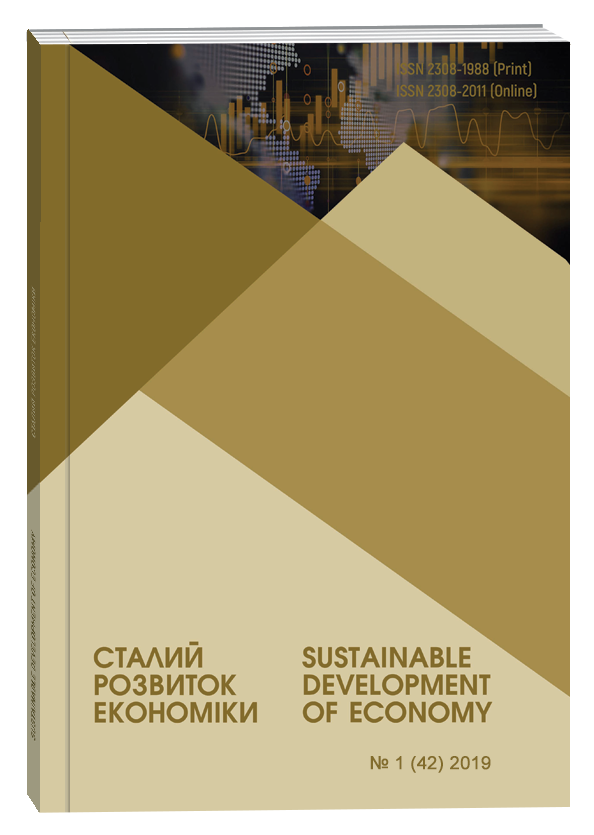GENERATION OF OWN INVESTMENT RESOURCES OF FINANCIAL PROVISION OF INNOVATIVE DEVELOPMENT OF ENTERPRISES
Abstract
Purpose. The aim of the article is the analysis of the influence of the useful life of economic objects on the generation of their own investment resources (in particular, amortization) of financial support for innovative development of enterprises. Methodology of research. The following research methods are used to achieve a certain goal: theoretical generalization and comparison (as the basis for studying the influence of the useful life of economic objects on the generation of own investment resources (in particular, amortization) of financial support for innovative development of enterprises); induction and deduction, grouping and generalization, logical method (as the basis for the correlation of amortization policy and the useful life of objects of non-current assets of the enterprise); monographic (when presenting the results of the study). Findings. The influence of the useful life of objects of economic activity on the generation of own investment resources of financial support of innovative development of enterprises was established, which allowed to develop an algorithm for determining and changing the useful life of objects of non-current assets, modified and upgraded as a result of innovative development of the enterprise. Originality. An algorithm for determining and changing the useful life of non-current assets objects, modified and upgraded as a result of innovative development of the enterprise, application of which in practice will facilitate the creation of conditions for more complete realization of the reproduction function of depreciation and ensuring its efficiency, is developed. Practical value. The main provisions of this study can be used by business entities when determining or changing the useful life of objects of non-current assets, modified and upgraded as a result of innovative development of the enterprise.
References
Горбовцов С. Розрахунок амортизації після модернізації. URL: https://consulting.dtkt.ua/state/other/8901 (дата звернення: 10.02.2019).
Жаліло Я.А. Теорія та практика формування ефективної економічної стратегії держави: монографія. Київ: НІСД, 2009. 178 c.
Козмірчук А. Корисність в економічній теорії та проблема її виміру. URL: https://kneu.edu.ua/ua/confere_nce/conf_social_dev_ukr_12/section3/Kozmirchuk/ (дата звернення: 10.02.2019).
Левченко Н.М., Нікітченко М.В. Алгоритм визначення строку корисного використання основних засобів. Сталий розвиток економіки: міжн. наук.-виробн. журнал. 2016. № 4(33). С. 95-102.
Макарович В.К., Балог Ш.Ш. Амортизаційна політика як фактор досягнення конкурентоспроможності підприємства. URL: https://dspace.uzhnu.edu.ua/.../ Makarovych%20V_K_75_.pdf (дата звернення: 12.02.2019).
Основні засоби: Міжнародний стандарт бухгалтерського обліку 16. URL: https://zakon.rada.gov.ua/go/929_014 (дата звернення: 12.02.2019).
Основні засоби: Положення (стандарт) бухгалтерського обліку 7. URL: http://www.zakon.rada.gov.ua/go/z0288-00 (дата звернення: 12.02.2019).
Павлюк А.П., Мєдвєдкова Н.С. Щодо особливостей та напрямів стимулювання інвестиційної діяльності підприємств у післякризовий період: Аналітична записка. URL: http://www.niss.gov.ua/articles/1053/ (дата звернення: 14.02.2019).
Платонова І.А. Проблеми обліку основних засобів в Україні. URL: http://intkonf.org/platonova-iaproblemi-obliku-osnovnih-zasobiv-v-ukrayini/ (дата звернення: 14.02.2019).
Податковий кодекс України від 02.12.2010 № 2755-VI. URL: http://zakon2.rada.gov.ua/laws/show/2755-17 (дата звернення: 15.02.2019).
Черкасов О.О. Особливості використання та відтворення основних засобів у сільському господарстві. Держава та регіони. 2015. № 5(86). С. 96-101.
Horbovtsov, S. “Calculation of depreciation after modernization”, available at: https://consulting.dtkt.ua/state/other/8901 (access date February 10, 2019).
Zhalilo, Ya.A. (2009), Teoriia ta praktyka formuvannia efektyvnoi ekonomichnoi stratehii derzhavy [Theory and practice of forming an effective economic strategy of the state], monograph, NISD, Kyiv, Ukraine, 178 p.
Kozmirchuk, A. “Utility in economic theory and the problem of its measurement”, available at: https://kneu.edu.ua/ua/confere_nce/conf_social_dev_ukr_12/section3/Kozmirchuk/ (access date February 10, 2019).
Levchenko, N.M. and Nikitchenko, M.V. (2016), “Algorithm for determining the useful life of fixed assets”, Stalyi rozvytok ekonomiky: mizhn. nauk.-vyrobn. zhurnal, no. 4(33), pp. 95-102.
Makarovych, V.K. and Baloh, Sh.Sh. “Amortization policy as a factor for achieving the competitiveness of the enterprise”, available at: https://dspace.uzhnu.edu.ua/.../ Makarovych%20V_K_75_.pdf (access date February 12, 2019).
Osnovni zasoby: Mizhnarodnyi standart bukhhalterskoho obliku 16 [Fixed assets: International accounting standard 16], available at: https://zakon.rada.gov.ua/go/929_014 (access date February 12, 2019).
Osnovni zasoby: Polozhennia (standart) bukhhalterskoho obliku 7 [Fixed assets: Regulation (standard) of accounting 7], available at: http://www.zakon.rada.gov.ua/go/z0288-00 (access date February 12, 2019).
Pavliuk, A.P. and Miedviedkova, N.S. “Regarding features and directions of stimulating investment activity of enterprises in the post-crisis period: An analytical note”, available at: http://www.niss.gov.ua/articles/1053/ (access date February 14, 2019).
Platonova, I.A. “Problems of accounting for fixed assets in Ukraine”, available at: http://intkonf.org/platonova-ia-problemi-obliku-osnovnih-zasobiv-v-ukrayini/ (access date February 14, 2019).
Verkhovna Rada Ukrainy (2010), Podatkovyi kodeks Ukrainy [Tax Code of Ukraine dated 02.10.2010 no. 2755-VI], available at: http://zakon2.rada.gov.ua/laws/show/2755-17 (access date February 12, 2019).
Cherkasov, O.O. (2015), “Features of use and reproduction of fixed assets in agriculture”, Derzhava ta rehiony, no. 5(86), pp. 96-101.


